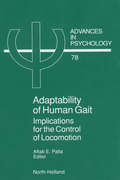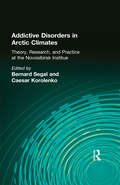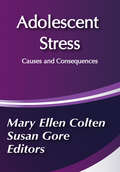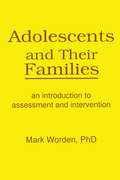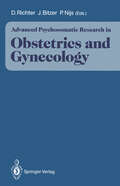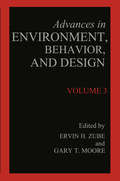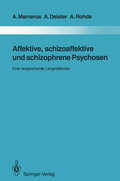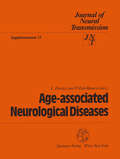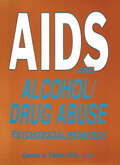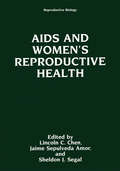- Table View
- List View
Adaptability of Human Gait: Implications for the Control of Locomotion (ISSN #Volume 78)
by A. E. PatlaA large number of volumes have been produced summarizing the work on generation and control of rhythmic movements, in particular locomotion. Unfortunately most of them focus on locomotor studies done on animals. This edited volume redresses that imbalance by focusing completely on human locomotor behaviour. The very nature of the problem has both necessitated and attracted researchers from a wide variety of disciplines ranging from psychology, neurophysiology, kinesiology, engineering, medicine to computer science. The different and unique perspectives they bring to this problem provide a comprehensive picture of the current state of knowledge on the generation and regulation of human locomotor behaviour.A common unifying theme of this volume is studying the adaptability of human gait to obtain insights into the control of locomotion. The intentional focus on "adaptability" is meant to draw attention to the importance of understanding the generation and regulation of "skilled locomotor behaviour" rather than just the generation of basic locomotor patterns which has been the major focus of animal studies. The synthesis chapter at the end of the volume examines how the questions posed, the technology, and the experimental and theoretical paradigms have evolved over the years, and what the future has in store for this important research domain.
Addictive Disorders in Arctic Climates: Theory, Research, and Practice at the Novosibirsk Institute
by Bernard SegalDiscover fresh perspectives on alcoholism treatment and research with this enlightening new book describing the work of researchers at the Novosibirsk Medical Institute, USSR. By using specific examples of their studies in Siberia, the reserachers offer an innovative approach to the treatment of addictive disorders in general. Instead of focusing on the drinking behavior itself, the treatment focuses on the relation of the problem to the interaction of economic, social, and psychological factors. To address the question of whether alcoholics should all be treated in the same way, or if alcholism treatment should be more individualized in approach, chapters are devoted to the differences between alcoholism in women, adolescents, and alchoholics who are afflicted with “rapid development of alcholism syndrome.” The research examples in Addictive Disorders in Arctic Climates benefits professionals involved in the treatment of alcholism by introducing new perspectives and broadening contemporary research.
Addictive Disorders in Arctic Climates: Theory, Research, and Practice at the Novosibirsk Institute
by Bernard SegalDiscover fresh perspectives on alcoholism treatment and research with this enlightening new book describing the work of researchers at the Novosibirsk Medical Institute, USSR. By using specific examples of their studies in Siberia, the reserachers offer an innovative approach to the treatment of addictive disorders in general. Instead of focusing on the drinking behavior itself, the treatment focuses on the relation of the problem to the interaction of economic, social, and psychological factors. To address the question of whether alcoholics should all be treated in the same way, or if alcholism treatment should be more individualized in approach, chapters are devoted to the differences between alcoholism in women, adolescents, and alchoholics who are afflicted with “rapid development of alcholism syndrome.” The research examples in Addictive Disorders in Arctic Climates benefits professionals involved in the treatment of alcholism by introducing new perspectives and broadening contemporary research.
Adolescent Group Therapy: A Social Competency Model
by Lucille Gordon Robert V. Heckel George R. HolmesThis book offers a health-oriented, integrative approach to adolescent group therapy. George R. Holmes and his associates believe that promoting social competency in each adolescent group member is central to successful therapy. The enablement of interpersonal skills neutralizes the environmentally sponsored psychopathology that adolescents use to survive. The authors also emphasize the co-therapy relationship. They offer recommendations for supervising trainee therapists and for applying their model to other contexts, such as high schools.The authors discuss strategies developed in their clinical work, covering such issues as scapegoating, silence, and withdrawal. They explore how processes, roles, and meaningful issues change over the life of the group. Social competency should be the main focus, they argue: it is essential to nurturing self-parenting skills and a healthy identity. The co-therapy relationship--the interaction between co-therapists and among co-therapists and group members--also greatly determines therapeutic change. The book includes recommendations for supervising trainee therapists and for applying this model to other contexts, such as high schools. Adolescent Group Therapy will be of interest to students and to teachers and professionals in psychology, counseling, vocational rehabilitation, social work, nursing, education, and child and adolescent psychiatry.
Adolescent Stress: Causes and Consequences (Social Institutions And Social Change Ser.)
by Mary ColtenAdolescent Stress concentrates on a range of major problems—those of a normal developmental nature as well as those of poor adaptation—identified in adolescents.
Adolescent Stress: Causes and Consequences
by Mary ColtenAdolescent Stress concentrates on a range of major problems—those of a normal developmental nature as well as those of poor adaptation—identified in adolescents.
Adolescents and Their Families: An Introduction to Assessment and Intervention
by Terry S Trepper Mark WordenThis comprehensive book introduces and integrates adolescent developmental themes and family system theory into a coherent assessment and intervention model. Author Mark Worden views the adolescent as active in shaping the family interactions as much as the family is influential in shaping the adolescent’s behavior. He takes a pragmatic approach to therapy, emphasizing what best explains the clinical phenomena and what works best for change. To this end, a heavy emphasis is placed on the process of evaluation and intervention of adolescents and their families with typical therapeutic dilemmas. This practical book is organized to take the reader through the first evaluation interview, through the planning of intervention strategies, and through the beginning, middle, and termination phases of treatment. Case examples bring Adolescents and Their Families to life, highlighting conceptual discussions. Topics discussed in this important book range from the integration of adolescent and family psychology, to the employment of a contextual-dialectic (“goodness-of-fit”) paradigm to evaluate adolescent-family interface, to matching the intervention with the family. A step-by-step discussion of the first interview and diverse intervention strategies are discussed, as are frequent clinical syndromes--acting-out, underachievement, eating disorders, divorce/single parenthood, depression, and suicide. Graduate students and clinicians will find this appealing book an ideal resource, as will experienced therapists beginning to work with adolescents and families. The book will also serve as an excellent primary or ancillary text for graduate courses in psychotherapy with adolescents and in family therapy courses. High school guidance counselors, social workers, and psychologists will also find many valuable applications in this timely book.
Adolescents and Their Families: An Introduction to Assessment and Intervention
by Terry S Trepper Mark WordenThis comprehensive book introduces and integrates adolescent developmental themes and family system theory into a coherent assessment and intervention model. Author Mark Worden views the adolescent as active in shaping the family interactions as much as the family is influential in shaping the adolescent’s behavior. He takes a pragmatic approach to therapy, emphasizing what best explains the clinical phenomena and what works best for change. To this end, a heavy emphasis is placed on the process of evaluation and intervention of adolescents and their families with typical therapeutic dilemmas. This practical book is organized to take the reader through the first evaluation interview, through the planning of intervention strategies, and through the beginning, middle, and termination phases of treatment. Case examples bring Adolescents and Their Families to life, highlighting conceptual discussions. Topics discussed in this important book range from the integration of adolescent and family psychology, to the employment of a contextual-dialectic (“goodness-of-fit”) paradigm to evaluate adolescent-family interface, to matching the intervention with the family. A step-by-step discussion of the first interview and diverse intervention strategies are discussed, as are frequent clinical syndromes--acting-out, underachievement, eating disorders, divorce/single parenthood, depression, and suicide. Graduate students and clinicians will find this appealing book an ideal resource, as will experienced therapists beginning to work with adolescents and families. The book will also serve as an excellent primary or ancillary text for graduate courses in psychotherapy with adolescents and in family therapy courses. High school guidance counselors, social workers, and psychologists will also find many valuable applications in this timely book.
Advanced Psychosomatic Research in Obstetrics and Gynecology
by PietNijs JohannesBitzer DietmarRichterGynecologists cannot fulfill the commitments of their profession without being psychosomatically oriented. Nevertheless, this field needs methodology and scientific thinking just as does any other subspeciality in clinical medicine. Although practiced by all gyne cologists, creative work is needed in order to develop the various aspects properly and to establish postgraduate training on a firm and sound basis. For this purpuse the European Symposia have been planned by several European Researchers on Psychosomatic Obstetrics and Gynecology in order to stimulate and integrate clinical scientific data and therapeutic skills in the bio-psycho-social field of obstetrics and gynecology. The first European Symposium in Leuven 1985 concentrated on the psychosomatic aspects of infertility and high risk pregnancies. This second European Symposium in Bad Sackingen centered around disturbed body perception, disturbances of the menstrual cycle, climacteric syndrome, and senium. These topics were elaborated in main lectures and workshops held by outstanding researchers in this rapidly expanding field. The second European Symposium on Psychosomatic Obstetrics and Gynecology was organized by the German Society of Psycho somatic Obstetrics and Gynecology, supported by the University Hospital Freiburg/Br., the University Hospital Basel, and the Women's District Hospital in Bad Sackingen.
Advances in Educational and Psychological Testing: Theory and Applications (Evaluation in Education and Human Services #28)
by Ronald K. Hambleton Jac N. ZaalOver the last 20 years there have been a large number of technical advances and changes in the field of educational and psychological testing. According to Anne Anastasi, The decade of the 1980's has been a period of unusual advances in ,psychological testing. Technological progress, theoretical sophistication, and increasing pro fessional responsibility are all evident in the fast-moving events in this field (A. Anastasi, Psychological Testing, Sixth Edition. New York: Macmillan, 1988). On the psychometric front, advances in topics such as item response theory, criterion-referenced measurement, generalizability theory,· analy sis of covariance structures, and validity generalization are reshaping the ways that ability and achievement tests are constructed and evaluated, and that test scores are interpreted. But \Jsychometric advances, as substantial and important as they have been, are only a fraction of the major changes in the field of testing. Today, for example, the computer is radically chang ing the ways in which tests are constructed, administered, and scored. Computers are being used to administer tests "adaptively." That is, the sequence of questions an examinee is administered depends upon his or her performance on earlier administered items in the test. Tests are "adapted" to the ability levels of the examinees who are being assessed. One result is shorter tests with little or no loss in measurement precision. Computers are also being used to store or bank test items. Later, items of interest can be selected, and the computer is used to print copies of the test.
Advances in Environment, Behavior, and Design: Volume 3 (Advances in Environment, Behavior and Design #3)
by Erwin H. Zube Gary T. MooreThis third volume in Advances in Environment, Behavior, and Design fol lows the conceptual framework adopted in the previous two volumes (see the Preface to Volume 1, 1987). It is organized into five sections advances in theory, advances in place, user group, and sociobehavioral research, and advances in research utilization. The authors of this volume represent a wide spectrum of the multi disciplinary environment-behavior and design field including architec ture, environmental psychology, facility management, geography, human factors, sociology, and urban design. The volume offers interna tional perspectives from North America (Carole Despres from Canada, several authors from the U.S.), Europe (Martin Krampen from Germany, Martin Symes from England), and New Zealand (David Kernohan). More so than any of the previous volumes, they are drawn from both academia and professional practice. While there continues to be a continuity in format in the series, we are actively exploring new directions that are on the cutting edges of the field and bode well for a more integrated future. This volume will fur ther develop the themes of design and professional practice to comple ment the earlier emphases on theory, research, and methods.
Affektive, schizoaffektive und schizophrene Psychosen: Eine vergleichende Langzeitstudie (Monographien aus dem Gesamtgebiete der Psychiatrie #65)
by Andreas Marneros Arno Deister Anke RohdeAge-associated Neurological Diseases (Journal of Neural Transmission. Supplementa #33)
by PeterDal-Bianco LüderDeeckeThe papers compiled in this supplementum are a selection of the best con th tributions presented at the 19 Central-European Neurological Symposium (CNS 19) held on June 29 - July 1, 1989 in Vienna. The main topic of this conference was degenerative and age-associated neurological diseases. In recent decades life expectancy has dramatically increased, at least in the industrialized countries. This has led to extreme distortions of the so-called population pyramids that no longer look like such but begin to almost resemble cylinders. As a consequence of this "overaging" of the population, diseases that are associated with age have become much more common than before. It was thus more than reasonable to devote a congress of the CNS series to these important neurological diseases. The following fields of interest are covered: Age-associated memory impairment (AAMI), Alzheimer's and other dementias, Parkinson's disease and other movement disorders, stroke and others. Concerning the de men tias, some papers deal with diagnosis employing neuro-imaging methods such as MRI, CT, PET and SPECT, others using electrophysiological methods. An important aspect in the early preclinical diagnosis of dementia is the inclusion of neuropsychological tests to enhance the chance of effec tive early treatment. Also drugs that are now under clinical investigation are discussed and preliminary results are presented.
AIDS and Alcohol/Drug Abuse: Psychosocial Research
by Dennis FisherAIDS is the number one health issue facing the nation today. The way in which AIDS relates to substance abuse is explored by drug abuse researchers in this timely volume. A major focus of AIDS and Alcohol/Drug Abuse is on the problems of conducting AIDS research on racial minorities in this country. Bringing together experts in the field, this volume examines the specific obstacles and challenges researchers have faced in assessing and addressing the needs of underserved populations and maps routes and procedures that can improve both research and available health care services.This unique volume also focuses on aspects of HIV infection that have received little attention elsewhere. It includes the first information published in the open literature about intravenous drug use in Alaska. Another chapter highlights some little-known facts that relate substance abuse to HIV infection in the American Indian/Alaskan Native population, among whom--it has been predicted--a devastating epidemic of HIV infection is likely. Problems with prevention, research, and treatment of individuals who are both intravenous drug users and who are infected with HIV are explored. Other chapters look at the transmission of HIV infection--by gay men who are alcoholics and by intravenous drug users. AIDS and Alcohol/Drug Abuse ends with hopeful chapter for AIDS prevention. Readers interested in the relationship of intravenous drug use and HIV infection, particularly among racial and ethnic minorities, will find this to be a practical, readable book. In particular, substance abuse counselors and researchers, and anyone involved in the AIDS prevention movement will find a valuable wealth of information.
AIDS and Alcohol/Drug Abuse: Psychosocial Research
by Dennis FisherAIDS is the number one health issue facing the nation today. The way in which AIDS relates to substance abuse is explored by drug abuse researchers in this timely volume. A major focus of AIDS and Alcohol/Drug Abuse is on the problems of conducting AIDS research on racial minorities in this country. Bringing together experts in the field, this volume examines the specific obstacles and challenges researchers have faced in assessing and addressing the needs of underserved populations and maps routes and procedures that can improve both research and available health care services.This unique volume also focuses on aspects of HIV infection that have received little attention elsewhere. It includes the first information published in the open literature about intravenous drug use in Alaska. Another chapter highlights some little-known facts that relate substance abuse to HIV infection in the American Indian/Alaskan Native population, among whom--it has been predicted--a devastating epidemic of HIV infection is likely. Problems with prevention, research, and treatment of individuals who are both intravenous drug users and who are infected with HIV are explored. Other chapters look at the transmission of HIV infection--by gay men who are alcoholics and by intravenous drug users. AIDS and Alcohol/Drug Abuse ends with hopeful chapter for AIDS prevention. Readers interested in the relationship of intravenous drug use and HIV infection, particularly among racial and ethnic minorities, will find this to be a practical, readable book. In particular, substance abuse counselors and researchers, and anyone involved in the AIDS prevention movement will find a valuable wealth of information.
AIDS and Women’s Reproductive Health (Reproductive Biology)
by Judith MassloAnderson Sheldon J. Segal Jaime SepulvedaAmor Lincoln C. ChenOver the past decade, the AIDS pandemic has propagated so widely and exerted such a dev astating impact that one may properly ask the question, Why not concentrate all AIDS efforts on disease control alone? Why link AIDS with women's reproductive health? What is the scientific basis for this linkage? And how might AID~ control and women's health objectives be promot ed simultaneously? These questions constitute the principal themes addressed in this monograph. The 15 chapters in this volume are intended to provide state-of-the-art reviews of key interac tions between AIDS and women's reproductive health for an audience of scientists and policy makers in the AIDS and population fields. Impetus for this monograph comes in pan from what we perceive to be an inadequate global response, thus far, to AIDS and women's health ;>roblems. A common platform has failed to emerge among the disparate professional communities working in the areas of AIDS, STDs, and family planning. As a result, endeavors in these fields have been isolated, and opportunities for joint action have been missed. An enormous and, as yet, unharnessed potential exists for power ful interdisciplinary collaborations that could strengthen policies and programs against these pressing health problems of humankind.
AIDS in America
by Charles H. RussellWhether one views it as an indictment of our lifestyle or merely as a The present volume is offered as a contribution to the information failure in the progress of science and medicine, the AIDS epidemic is campaign in the battle against the epidemic. It rests on the conviction undoubted I y one of the most agonizing experiences of our time. There that the increase of knowledge about AIDS will help to elevate the is hope for control of the disease--especially so in the development of power of public judgement, including a sense of moral restraint, to the an anti-AIDS vaccine-but the following stark facts are too over point necessary to bring about control and halt further spread of this powering for anyone to behold without sensing pain. Already close to terrible disease. The study as a whole, as well as the epidemic itself, 100,000 (or possibly more at this date) Americans have died of the raises questions about social ethics and about whether we may have disease, another 161,000 cases have been diagnosed, and estimates adopted a social philosophy which allows us to exceed appropriate place the additional number of infected persons at 1 million. 35,000 limits of independent personal behavior on the assumption that the new AIDS cases are reported annually in America, with a nearly equal consequences of our acts can always be managed by some sort of distribution among heterosexual and homosexual persons. technological fix.
Alcohol (Drugs of Abuse: A Comprehensive Series for Clinicians #2)
by Norman S. Miller Mark S. GoldThis book is written for a truly general medical audience. Clinicians, researchers, residents, and students will find Al cohol a direct treatment of the major drug problem in Amer ica. Along with the first volume in this series on marijuana, Alcohol is timely and relevant. The subject is presented with clarity in an effort to provide professionals and interested readers with a basic background in the field of alcohol studies. The emphasis is on what is known and can be coun ted on as fundamental knowledge on the various aspects of history, epidemiology, diagnosis, treatment, and prevention of alcoholism. Because drugs other than alcohol are such an important feature of the contemporary alcoholic, they are covered as a part of the natural history of alcoholism. Change and progress are essential to knowledge; past and current research in the alcohol field, as well as detailed discussions of what further needs to be investigated, are in cluded in the volume. The student as well as the practitioner vii viii PREFACE will find the contents useful for didactic purposes as well as a clinical reference. We believe that the researcher will also profit from the comprehensive coverage of the subject. The chapters are organized in sections to highlight important topics and are arranged in a sequence to ensure a logical de velopment of the subject, alcohol. Throughout the book we combine our clinical and research experiences to provide a synthesis that we hope will have widespread clinical usefulness. N.S.M.
Alcohol Education and Young Offenders: Medium and Short Term Effectiveness of Education Programs (Recent Research in Psychology)
by Steve BaldwinSince the establishment of the first alcohol education course (ABC) for young offenders in 1981, this fono of service delivery has been expanded across the United Kingdom. While some before-and-after data have been reported, no con trolled evaluations have been completed on effectiveness with this type of inter vention. The present research reports a series of evaluation studies to investigate the impact of ABCs on offending and drinking behavior. Young offenders were recruited from local courts. The first study, completed in Dundee, reported results from a comparative evaluation between two types of ABCs. As an attention-placebo study, one group received a behavioral ABC with program contents designed to reduce drinking and offending behaviors. Some dependent variable differences between the two groups were observed at follow-up. The second study was established in Glasgow as a replication of the main study. The third study used a quasi-experimental design to establish a no-intervention control group in the Perth courts. Young offenders were recruited to complete screening interviews, without any intervention. The intervention group was re cruited from courts in Forfar, a similar rural town. This group completed an infonoation-based ABC, using educational materials about alcohol and its effects. Some dependent variable differences were observed at follow-up. The fourth study was based in a Young Offender Institution at Forfar. Prerelease young offenders were randomly assigned to either a no-intervention control group or a behavioral ABC group. Some dependent variable differences were reported at follow-up.
All My Sins Remembered: Another Part of a Life & The Other Side of Genius: Family Letters
by Wilfred R. BionAll My Sins Remembered is the continuation of Wilfred Bion's autobiography, The Long Week-end. Although it is by no means a full account of his thirty years following the First World War - and he wrote no more - his memories of that period contrast vividly with the impression we gain of the following thirty years of his life through his letters. The Other Side of Genius gives us a glimpse of this remarkable man as his family knew him: those who met him only through his professional work will find here the same characteristic threads of humour, concern for truth, and flashes of insight that were the hallmark of his work in psycho-analysis.OXFORD: 'Thus opened for me a period of unparalleled opportunities to which I remained obstinately blind. I was overwhelmed before I started by the aura of intellectual brilliance with which Oxford was surrounded'.
All My Sins Remembered: Another Part of a Life & The Other Side of Genius: Family Letters
by Wilfred R. BionAll My Sins Remembered is the continuation of Wilfred Bion's autobiography, The Long Week-end. Although it is by no means a full account of his thirty years following the First World War - and he wrote no more - his memories of that period contrast vividly with the impression we gain of the following thirty years of his life through his letters. The Other Side of Genius gives us a glimpse of this remarkable man as his family knew him: those who met him only through his professional work will find here the same characteristic threads of humour, concern for truth, and flashes of insight that were the hallmark of his work in psycho-analysis.OXFORD: 'Thus opened for me a period of unparalleled opportunities to which I remained obstinately blind. I was overwhelmed before I started by the aura of intellectual brilliance with which Oxford was surrounded'.
The Altruism Question: Toward A Social-psychological Answer
by C. Daniel BatsonAre our efforts to help others ever driven solely by altruistic motivation, or is our ultimate goal always some form of self- benefit (egoistic motivation)? This volume reports the development of an empirically-testable theory of altruistic motivation and a series of experiments designed to test that theory. It sets the issue of egoism versus altruism in its larger historical and philosophical context, and brings diverse experiments into a single, integrated argument. Readers will find that this book provides a solid base of information from which questions surrounding the existence of altruistic motivation can be further investigated.
The Altruism Question: Toward A Social-psychological Answer
by C. Daniel BatsonAre our efforts to help others ever driven solely by altruistic motivation, or is our ultimate goal always some form of self- benefit (egoistic motivation)? This volume reports the development of an empirically-testable theory of altruistic motivation and a series of experiments designed to test that theory. It sets the issue of egoism versus altruism in its larger historical and philosophical context, and brings diverse experiments into a single, integrated argument. Readers will find that this book provides a solid base of information from which questions surrounding the existence of altruistic motivation can be further investigated.
Alzheimer's Day Care: A Basic Guide (Series in Death, Dying, and Bereavement)
by David A. Linderman Nancy H. Corby Rachel Downing Beverly SanbornA book whose purpose is to offer guidance to individuals, organizations and agencies on how to develop day care programmes for patients with Alzheimer's disease or a related dementia. A range of programme aspects are covered from administrative details to social factors and evaluation techniques.
Alzheimer's Day Care: A Basic Guide (Series in Death, Dying, and Bereavement)
by David A. Linderman Nancy H. Corby Rachel Downing Beverly SanbornA book whose purpose is to offer guidance to individuals, organizations and agencies on how to develop day care programmes for patients with Alzheimer's disease or a related dementia. A range of programme aspects are covered from administrative details to social factors and evaluation techniques.
